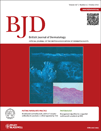A comparison of serum inflammatory cytokines according to phenotype in patients with psoriasis
Funding sources This work was supported by Konkuk University Hospital in 2012.
Conflicts of interest None declared.
Abstract
Summary Background Plaque-type psoriasis manifests with various morphological phenotypes and different clinical activity over time in the same individual or from one patient to another. Circulating cytokines, especially T-helper (Th) 1- and Th17-related, have been suggested to reflect the inflammatory nature of psoriasis. However, studies regarding cytokine profile according to morphological phenotypes are quite scarce.
Objectives We sought to analyse the circulating Th1 and Th17 cytokines according to clinical phenotype and investigated the correlation between disease severity [Psoriasis Area and Severity Index (PASI)] and the serum level of inflammatory cytokines.
Methods Seventy-one patients with psoriasis were divided into two groups according to clinical phenotype: chronic stable (CS) and eruptive inflammatory (EI). Th1- and Th17-derived cytokines were measured using multiplex cytokine assay.
Results It was noted that interleukin (IL)-1 receptor antagonist and IL-17A were elevated in the EI group compared with the CS group. We also noticed that the PASI is relatively well correlated with serum cytokine level in the CS state but not as well in the EI counterpart.
Conclusions The level of serum inflammatory cytokines differs according to morphological phenotype. Also, the PASI does not seem to be a suitable tool to assess disease severity in patients with psoriasis with EI characteristics.




